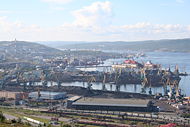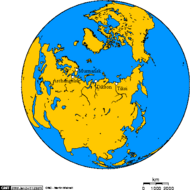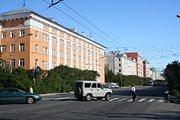Murmansk
| Murmansk (English) Мурманск (Russian) |
|
|---|---|
 Murmansk Port |
|
 Murmansk on the map of the North Pole region |
|
| Coordinates |
|
| Coat of Arms | Flag |
 |
 |
| City Day: October 4 | |
| Administrative status | |
| Federal subject In jurisdiction of Administrative center of |
Murmansk Oblast Murmansk Oblast Murmansk Oblast |
| Local self-government | |
| Charter | Charter of Murmansk |
| Municipal status | Urban okrug |
| Head | Mikhail Savchenko |
| Legislative body | Council of Deputies |
| Area | |
| Area | 150.55 km² (58.1 sq mi) |
| Population (as of the 2002 Census) | |
| Population - Rank - Density |
336,137 inhabitants 52nd 2,232.7/km² (5,782.7/sq mi) |
| Events | |
| Founded | October 4, 1916 |
| Town status | 1916 |
| Renamed Murmansk | April 1917 |
| Other information | |
| Postal code | 183000..183099 |
| Dialing code | +7 8152 |
| Official website | |
| http://www.gov-murman.ru/mun/murmansk/ | |
Murmansk (Russian: Му́рманск; Northern Sami: Murmanska; Skolt Sami: Muurman) is a city and seaport in the extreme northwest part of Russia, on the Kola Bay, 12 km from the Barents Sea on the northern shore of the Kola Peninsula, not far from Russia's borders with Norway and Finland.
Murmansk is the administrative centre of Murmansk Oblast. The port remains ice-free year round due to the warm North Atlantic drift ocean current and is an important fishing and shipping port. Its satellite, Severomorsk, is an important navy base for the Russian Navy. It is home port to Atomflot, the world's only fleet of nuclear-powered ice breakers. [1] [2]

Murmansk is the largest city north of the Arctic Circle. Population: 336,137 (2002 Census);[3] 468,039 (1989 Census).[4]
Contents[hide] |
History
Murmansk was the last town founded in the Russian Empire. The Murman is a traditional Pomor name for the Barents Sea and derives from the Old Russian word for Norwegians, "murmane", which is cognate to English "Normans".[5]
The city, known initially as Romanov-on-the-Murman (Рома́нов-на-Му́рмане), was founded on October 4, 1916 and named after the Russian royal dynasty of the Romanovs. The city, the only ice-free port in the Russian Arctic, was built as a terminus of the railroad line to Kola designed to open the North Atlantic supply route to Russia in support of the Eastern Front during the First World War. The city was renamed Murmansk after the February Revolution in 1917.
From 1918 to 1920, the city was occupied by the Western powers who had been allied in the First World War and "White" forces during the Civil War in Russia.[6]
During World War II, Murmansk was a link with the Western world for Russia, and a vast commerce with the Allies, in items important to the respective military efforts passed through it: primarily manufactured and raw materials goods into the Soviet Union. These supplies were brought to the city in the Arctic Convoys.
A joint German and Finnish force launched an offensive against the city in 1941 as part of Operation Silver Fox. Murmansk suffered profound destruction, second only to Stalingrad of all the Soviet cities.[7][8] However, fierce Soviet resistance and unforgiving territory prevented the Germans from capturing the city and from cutting off the vital Karelian railway line. This resistance was eventually recognized in 1985 by the Soviet Union with the formal designation of Murmansk as a Hero City on May 6, 1985 [9]. In commemoration of this event, the massive statue Alyosha, depicting a Russian soldier of World War II, was erected overlooking the city harbour. For the rest of the war, it served as a transit point for weapons and other supplies entering the Soviet Union from other Allied nations.
During the Cold War it was a centre of Soviet submarine activity, and since the breakup of the USSR, it remains the headquarters of the Russian Northern Fleet.
To commemorate the 85th anniversary of the city's foundation, the snow-white church of the Saviour-on-Waters was modeled after the White Monuments of Vladimir and Suzdal and built on the shore for sailors of Murmansk (photograph).
Murmansk's evening newspaper is Vecherny Murmansk, published since 1991.
Arctic Bridge
Murmansk is set to be the Russian terminus of the Arctic Bridge (or Arctic Sea Bridge), a sea route that would link it to the Canadian port of Churchill, Manitoba. This passage has not yet been fully tested for commercial shipping but Russia has shown interest in it. Once this bridge is further developed (along with the Northwest Passage) it is believed that it will serve as a major trade route between Europe and Asia.
Twin Towns - Sister Cities
Murmansk is twinned or has sister city relationships with:
|
Climate
| [hide] |
|||||||||||||
|---|---|---|---|---|---|---|---|---|---|---|---|---|---|
| Month | Jan | Feb | Mar | Apr | May | Jun | Jul | Aug | Sep | Oct | Nov | Dec | Year |
| Record high °C (°F) | 7.0 (45) |
6.6 (44) |
9.0 (48) |
16.9 (62) |
27.2 (81) |
30.8 (87) |
32.9 (91) |
29.1 (84) |
24.2 (76) |
15.0 (59) |
9.6 (49) |
5.6 (42) |
32.9 (91) |
| Average high °C (°F) | -7.2 (19) |
-7.3 (19) |
-3.3 (26) |
1.9 (35) |
7.2 (45) |
14.0 (57) |
17.2 (63) |
15.2 (59) |
9.6 (49) |
2.9 (37) |
-2.0 (28) |
-5.3 (22) |
3.7 (39) |
| Average low °C (°F) | -13.8 (7) |
-13.4 (8) |
-9.8 (14) |
-4.4 (24) |
0.6 (33) |
5.7 (42) |
8.8 (48) |
8.0 (46) |
4.3 (40) |
-1.2 (30) |
-7.0 (19) |
-11.4 (11) |
-2.7 (27) |
| Record low °C (°F) | -39.4 (-39) |
-38.6 (-37) |
-32.6 (-27) |
-23.0 (-9) |
-10.4 (13) |
-2.5 (28) |
1.7 (35) |
-2.0 (28) |
-5.4 (22) |
-21.2 (-6) |
-30.3 (-23) |
-35.0 (-31) |
-39.4 (-39) |
| Precipitation mm (inches) | 30 (1.18) |
22 (0.87) |
19 (0.75) |
20 (0.79) |
30 (1.18) |
53 (2.09) |
61 (2.4) |
65 (2.56) |
53 (2.09) |
44 (1.73) |
40 (1.57) |
36 (1.42) |
473 (18.62) |
| Source: Pogoda.ru.net[12] 8.09.2007 | |||||||||||||
Gallery
References
- ↑ MSCO: Fleet: Icebreaking fleet
- ↑ Atomflot - Bellona
- ↑ Федеральная служба государственной статистики (Federal State Statistics Service) (2004-05-21). "Численность населения России, субъектов Российской Федерации в составе федеральных округов, районов, городских поселений, сельских населённых пунктов – районных центров и сельских населённых пунктов с населением 3 тысячи и более человек (Population of Russia, its federal districts, federal subjects, districts, urban localities, rural localities—administrative centers, and rural localities with population of over 3,000)" (in Russian). Всероссийская перепись населения 2002 года (All-Russia Population Census of 2002). Federal State Statistics Service. Retrieved on 2008-07-25.
- ↑ "Всесоюзная перепись населения 1989 г. Численность наличного населения союзных и автономных республик, автономных областей и округов, краёв, областей, районов, городских поселений и сёл-райцентров. (All Union Population Census of 1989. Present population of union and autonomous republics, autonomous oblasts and okrugs, krais, oblasts, districts, urban settlements, and villages serving as district administrative centers.)" (in Russian). Всесоюзная перепись населения 1989 года (All-Union Population Census of 1989). Demoscope Weekly (website of the Institute of Demographics of the State University—Higher School of Economics (1989). Retrieved on 2007-12-13.
- ↑ Max Vasmer's Etymological Dictionary, trans. by Oleg Trubachev, vol. 3, p. 13.
- ↑ Bolshevik, North Russian, Royal Navy, Expeditionary Force, Archangel, Dvina River
- ↑ Мурманску исполняется 90 лет
- ↑ Газета «Вечерний Мурманск» Выпуск № 93 от 28 мая 2005
- ↑ Nature » Administrative-territorial system
- ↑ "Kaliningrad -Partner Cities". © 2000-2006 Kaliningrad City Hall. Retrieved on 2008-12-08.
- ↑ "Groningen - Partner Cities". © 2008 Gemeente Groningen, Kreupelstraat 1,9712 HW Groningen. Retrieved on 2008-12-08.
- ↑ "Pogoda.ru.net" (in Russian). Retrieved on September 8, 2007.
External links
- Murmansk: Info,News,Photo
- Murmansk Travelling Agent
- Atomic ice breaker fleet
- Murmansk's gorgeous garages — a photo journal by BBC news journalist Jorn Madslien
- Murmansk travel guide
- Satellite picture by Google Maps
- Map of Murmansk
- Views of Murmansk group on Flickr
- Murmansk State Technical University
- British North Russian Expeditionary Force 1918–1919 (based at Murmansk)
- "Big-dollar deals tempt Arctic firms" BBC article on the energy industry's effect on Murmansk
- Image of "Alyosha" statue
|
||||
|
||